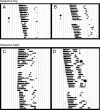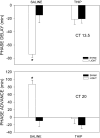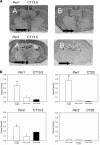Regulation of light's action in the mammalian circadian clock: role of the extrasynaptic GABAA receptor
- PMID: 19244580
- PMCID: PMC2689827
- DOI: 10.1152/ajpregu.90878.2008
Regulation of light's action in the mammalian circadian clock: role of the extrasynaptic GABAA receptor
Abstract
GABA(A) receptor agonists act in the suprachiasmatic nucleus (SCN) to reset circadian rhythms during the day but inhibit the ability of light to reset rhythms during the night. In the present study, we examined whether these paradoxical differences in the effect of GABA(A) receptor stimulation on the circadian system are mediated by separate GABA(A) receptor subtypes. 4,5,6,7-Tetrahydroisoxazolo[5,4-c]pyridin-3-ol (THIP), a GABA(A) receptor agonist, preferentially activates GABA(A) receptors in extrasynaptic locations. THIP, muscimol (a GABA(A) agonist), or vehicle were microinjected into the SCN region of Syrian hamsters free-running in constant darkness during the mid-subjective day, early subjective night, or late subjective night. The subjective night injections were followed by a light pulse or sham control. Behavioral phase shifts of wheel running rhythms and both Period1 (Per1) and Per2 mRNA levels in the SCN were assessed. Animals that received THIP during the subjective day did not exhibit significant phase alterations. During the early and late subjective night, however, THIP abolished the phase-shifting effects of light and the ability of light to increase Per1 and Per2 mRNA levels. The ability of N-methyl-d-aspartic acid to phase-shift wheel running rhythms was also attenuated by THIP. Together these data demonstrate that THIP does not produce phase shifts during the subjective day, but does inhibit the ability of light to produce phase shifts. Thus, extrasynaptic GABA(A) receptors appear to play a role in regulating light input to the SCN, while a different population of GABA(A) receptors appears to be responsible for daytime effects of GABA.
Figures




Similar articles
-
Light and GABA)(A) receptor activation alter period mRNA levels in the SCN of diurnal Nile grass rats.Eur J Neurosci. 2006 Nov;24(10):2843-52. doi: 10.1111/j.1460-9568.2006.05166.x. Eur J Neurosci. 2006. PMID: 17156208
-
GABA interacts with photic signaling in the suprachiasmatic nucleus to regulate circadian phase shifts.Neuroscience. 2002;109(4):773-8. doi: 10.1016/s0306-4522(01)00519-x. Neuroscience. 2002. PMID: 11927159
-
Interactions of GABA A receptor activation and light on period mRNA expression in the suprachiasmatic nucleus.J Biol Rhythms. 2008 Feb;23(1):16-25. doi: 10.1177/0748730407310785. J Biol Rhythms. 2008. PMID: 18258754
-
Hormones, subjective night and season of the year.Physiol Res. 2000;49 Suppl 1:S1-10. Physiol Res. 2000. PMID: 10984066 Review.
-
The dynamics of GABA signaling: Revelations from the circadian pacemaker in the suprachiasmatic nucleus.Front Neuroendocrinol. 2017 Jan;44:35-82. doi: 10.1016/j.yfrne.2016.11.003. Epub 2016 Nov 25. Front Neuroendocrinol. 2017. PMID: 27894927 Free PMC article. Review.
Cited by
-
Physiological responses of the circadian clock to acute light exposure at night.Rev Endocr Metab Disord. 2009 Dec;10(4):279-91. doi: 10.1007/s11154-009-9116-6. Rev Endocr Metab Disord. 2009. PMID: 19768549 Review.
-
Zfhx3 modulates retinal sensitivity and circadian responses to light.FASEB J. 2021 Sep;35(9):e21802. doi: 10.1096/fj.202100563R. FASEB J. 2021. PMID: 34383984 Free PMC article.
-
Doublecortin-like expressing astrocytes of the suprachiasmatic nucleus are implicated in the biosynthesis of vasopressin and influences circadian rhythms.Glia. 2021 Nov;69(11):2752-2766. doi: 10.1002/glia.24069. Epub 2021 Aug 3. Glia. 2021. PMID: 34343377 Free PMC article.
-
Localization and expression of GABA transporters in the suprachiasmatic nucleus.Eur J Neurosci. 2015 Dec;42(12):3018-32. doi: 10.1111/ejn.13083. Epub 2015 Dec 8. Eur J Neurosci. 2015. PMID: 26390912 Free PMC article.
-
Ethanol modulates mammalian circadian clock phase resetting through extrasynaptic GABA receptor activation.Neuroscience. 2009 Dec 1;164(2):842-8. doi: 10.1016/j.neuroscience.2009.08.020. Epub 2009 Aug 18. Neuroscience. 2009. PMID: 19695310 Free PMC article.
References
-
- Adkins CE, Pillai GV, Kerby J, Bonnert TP, Haldon C, McKernan RM, Gonzalez JE, Oades K, Whiting PJ, Simpson PB. α4β3Δ GABA(A) receptors characterized by fluorescence resonance energy transfer-derived measurements of membrane potential. J Biol Chem 276: 38934–38939, 2001. - PubMed
-
- Albrecht U Invited review: regulation of mammalian circadian clock genes. J Appl Physiol 92: 1348–1355, 2002. - PubMed
-
- Albus H, Vansteensel MJ, Michel S, Block GD, Meijer JH. A GABAergic mechanism is necessary for coupling dissociable ventral and dorsal regional oscillators within the circadian clock. Curr Biol 15: 886–893, 2005. - PubMed
-
- Belenky MA, Yarom Y, Pickard GE. Heterogeneous expression of γ-aminobutyric acid and γ-aminobutyric acid-associated receptors and transporters in the rat suprachiasmatic nucleus. J Comp Neurol 506: 708–732, 2008. - PubMed
-
- Boehm SL, Homanics GE, Blednov YA, Harris RA. δ-Subunit containing GABAA receptor knockout mice are less sensitive to the actions of 4,5,6,7-tetrahydroisoxazolo-[5,4-c]pyridin-3-ol. Eur J Pharmacol 541: 158–162, 2006. - PubMed
Publication types
MeSH terms
Substances
Grants and funding
LinkOut - more resources
Full Text Sources
Other Literature Sources

